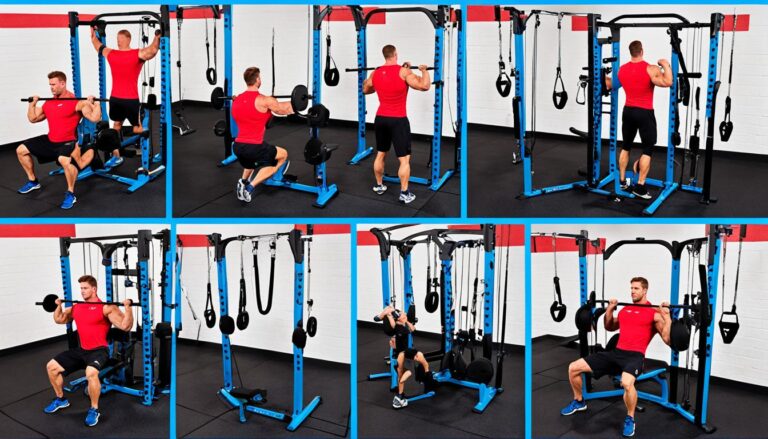When it comes to sculpting our bodies and enhancing our strength, the debate between Cable Exercises Vs Free Weights is as old as the gym culture itself. Yet, the choice isn’t necessarily as black and white as some would suggest. As a fitness enthusiast who has navigated the nuanced landscape of the gym, I’ve come to appreciate both the subtlety of muscle activation with cable exercises and the primal satisfaction of muscle building with free weights. Each method offers its own unique set of benefits that are invaluable to any well-rounded fitness regimen.
Having committed countless hours to lifting, pulling, and stretching at various angles, I’ve personally witnessed how these different methods can shape and modify the human body. What makes for an effective workout is understanding that these tools are not adversaries; instead, they complement each other, serving distinct purposes and adapting to our body’s needs. Weaving the narrative of my fitness journey, I aim to unpack the value each approach brings to the table—be it the precise muscle engagement of cables or the all-encompassing challenge of free weights.
Key Takeaways
- Cable exercises and free weights serve unique roles in a fitness routine.
- Muscle activation with cable exercises offers targeted conditioning.
- Free weights excel in building comprehensive muscle strength.
- Combining both methods can lead to a more balanced physical development.
- Understanding the impact of each method allows for a personalized fitness plan.
- A nuanced perspective is key to appreciating the full spectrum of gym equipment.
The Fundamental Differences Between Cable Exercises and Free Weights
When it comes to choosing the right equipment for strength training, understanding the differences between cable exercises and free weights is crucial. Each type of equipment offers unique benefits and challenges to your workout routine. Delving into aspects such as resistance variability, range of motion, and the interaction between equipment stability and user coordination can help elucidate these differences.
In my years of experience, I’ve found cable machines vs free weights present nuances that can significantly impact one’s fitness journey. For a deeper understanding, let’s explore three fundamental distinctions:
Understanding Resistance Variability
Cable exercises offer a continuous tension throughout the movement, which can lead to increased muscle activation in specific areas. This is in contrast to free weights, where the resistance can vary according to the gravity and angle of the motion. This variability with free weights can be beneficial for developing muscle strength in a more holistic manner since it encourages the adaptation to different stress points during lifts.
Range of Motion: Cables vs Dumbbells and Barbells
The range of motion offered by cable machines is typically more controlled compared to free weights. This can be particularly advantageous for those new to weightlifting or those recovering from injury, as it allows for precise movement without the risk of straying from the correct path. On the other hand, free weights promote dynamic movement patterns that activate various muscle groups simultaneously, enhancing functional strength and coordination.
Equipment Stability and User Coordination
Using free weights requires a higher degree of coordination and core stability since you are tasked with controlling the weight throughout the exercise. This involvement of multiple muscle groups can lead to improved balance and proprioception. Conversely, cable machines provide stability in the weight path, allowing the user to focus more intensely on the muscle being targeted, which can be particularly helpful for isolation exercises.
For further insights into integrating both types of fitness equipment into a well-rounded exercise program, consider visiting this useful guide on cable workouts and free that explores both setups in depth.
By examining these foundational differences, enthusiasts and athletes alike can make more informed decisions tailored to their personal fitness goals, understanding how each equipment type suits different training needs and outcomes.0123456789>
Why Cable Machines Can Be Superior for Certain Goals
Exploring the distinct advantages of cable machines, what stands out most significantly is their ability to offer consistent tension throughout exercises. This can be particularly pivotal for those who are intent on achieving precise physical outcomes, such as targeted muscle engagement and effective strength training.
Consistent Tension Throughout Exercises
The core benefit of cable exercises lies in the constant resistance they provide. Unlike free weights, where the tension can vary based on the angle of the exercise, cable machines maintain steady resistance. This feature is particularly beneficial when looking to enhance muscle activation through a complete range of motion. Cable exercises for strength training ensure that each phase of the movement is equally challenging, promoting a more balanced muscle growth and strength.
Cable Exercises for Targeted Muscle Engagement
If your training goals include sculpting specific muscle groups, understanding the benefits of cable exercises becomes crucial. The precision with which one can target muscles is unparalleled in cable setups. For instance, adjustable pulleys allow you to work muscles from a variety of angles, thereby hitting muscle fibers that might be neglected through standard lifts with free weights.
Built-in Safety and Easier Learning Curve
For novices and those rehabilitating from injuries, the built-in safety that cable machines offer can be a game-changer. The reduced risk of dropping weights on oneself and the lack of balance forces needed compared to free weights make cable machines a safer, more accessible option. Furthermore, the learning curve with cable machines is generally smoother, allowing practitioners to focus on the form and execution of their moves without the intimidation often associated with free weights.
By incorporating cable machines into your workout regimen, you’re not just investing in equipment; you’re also investing in a versatile tool that will help you achieve your fitness and rehabilitation goals effectively. The benefits of cable exercises stretch beyond basic strength training, offering targeted muscle engagement that is both profound and productive.
The Advantages of Using Free Weights for Fitness Enthusiasts
From my extensive experience and keen observations in fitness, I have found distinct advantages of using free weights that cater particularly well to fitness lovers. Unlike machines, free weights allow for a full range of motion, crucial for effective muscle building and overall fitness.
One of the standout benefits of employing free weights for muscle building is their ability to engage multiple muscle groups simultaneously. When you perform compound movements with free weights, you are not only working the primary muscles but also the surrounding stabilizers. This holistic approach promotes more functional fitness, enhancing both strength and coordination in a way that mimics real-world activities.
- Increased metabolic rate from muscle engagement
- Greater exercise versatility and flexibility
- Improvement in muscular balance and symmetry
By integrating compound movements into my routines, I have personally witnessed a remarkable improvement in my strength and flexibility. These exercises, such as squats, deadlifts, and bench presses, are pivotal for anyone looking to enhance their physical health and athletic performance.
Moreover, the practicality of free weights extends beyond the gym. They require minimal space and can be used virtually anywhere, making them ideal for maintaining a consistent workout schedule. This versatility is particularly beneficial for those with busy lifestyles who may not have access to a full gym.
In conclusion, the advantages of using free weights are multifaceted, delivering not only muscular gains but also encouraging a wider range of motion and engaging more complex muscle groups. Whether you’re at home or in a gym, incorporating free weights into your fitness regimen can lead to significant and satisfying fitness progress.
My Experience with Muscle Activation During Cable Workouts
As someone passionate about fitness, exploring different strength training methods has been a staple of my routine. Among them, cable exercises have stood out due to their distinct cable resistance capabilities, which have significantly influenced my muscle activation patterns. This type of training has not only enhanced my back muscle development but also improved my overall understanding of how muscle activation with cable exercises can transform a workout regimen.

What’s remarkable about cable machines is their ability to maintain steady tension throughout each motion. This consistency is crucial for muscle activation as it ensures that no part of the motion lacks resistance, thereby challenging the muscles continuously and effectively throughout the workout.
How Cable Resistance Impacts Muscle Contraction
The cable resistance is uniquely advantageous because it creates an unrelenting tension that requires constant muscle engagement. This aspect of cable workouts means that each pull or lift isn’t just about moving weights from point A to B but rather creating a controlled environment where muscles are constantly activated. For instance, during a cable row, the steady pull back and the controlled release forward demand that my back muscles remain engaged, promoting better muscle growth and endurance over time.
Personal Insights on Mind-Muscle Connection with Cables
Developing a strong mind-muscle connection has been a transformative element in my training, particularly with cable workouts. I’ve found that the set path of the cables allows for a focus that free weights cannot always replicate. This focus helps in visually and mentally connecting with the muscles being worked, like feeling each fiber of my back muscles contract and release. This connection is not just psychological but impacts physical performance, leading to improvements in muscle strength and aesthetics—a key reason many athletes and fitness enthusiasts prefer cable exercises. yuponents.”
One particularly helpful resource I found is a comprehensive guide on back cable exercises that can help anyone looking to enhance their muscle activation and development through cable resistance. This guide covers essential workouts that target the back muscles effectively, ensuring comprehensive muscle growth and strength.
In conclusion, integrating cable machines into my workout routine has not only optimized muscle activation with cable exercises but also maximized the efficiency of each session. Whether through isolated movements or compound sets, the benefits of cable resistance and the mind-muscle connection they foster are undeniable.
Exploring the Benefits of Cable Exercises for Strength Training
As I delve into the benefits of cable exercises for strength training, one cannot overlook their versatility and efficacy. Cable exercises offer a unique resistance that helps in targeted muscle engagement, which is crucial for both novice and advanced fitness practitioners. Unlike free weights, which rely on gravity, cable machines create constant tension throughout the movement, a key component in stimulating muscle growth and strength.
The advantages of using cables don’t stop at muscle growth; they also contribute significantly to muscle endurance and coordination, paving the way for a well-rounded fitness routine. For those aiming to enhance their strength, incorporating cable exercises for strength quicker adaptations and better form can make a noticeable difference.
Using cable machines allows me to focus more on my form and less on balancing the weights, which is especially beneficial during isolated strength exercises.
Another pivotal aspect of cable machines is their ability to provide a controlled environment that can be adjusted according to individual strength levels. This adaptability is not just beneficial for newbies but also for experienced athletes looking to push their limits without compromising on safety.
- Incremental adjustments for weight
- Smooth resistance provides less impact on the joints
- Ability to target different muscle groups effectively
Furthermore, the conservation of muscle energy due to continuous resistance ensures that each rep is more effective at muscle strain and subsequent recovery, leading to solid gains. To learn more about specific routines, visit this helpful guide on cable workout for biceps which can facilitate targeted muscle growth through tailored exercises.
Integrating cable exercises into a fitness routine not only diversifies what can sometimes become monotonous with typical free weight repetitions but also ensures that muscles are engaged differently with each workout. This approach to fitness provides a comprehensive growth spectrum that traditional weights cannot always offer.
Navigating the Myths: Cable Machines Vs Free Weights
Throughout my fitness journey, the debate surrounding cable machines vs free weights has been omnipresent, often clouded by myths in fitness. Today, I aim to address these misconceptions with a focus on dispelling common myths and shedding light on the true effectiveness of each training modality.

One prevalent myth is that cable machines are only for beginners. This notion undermines the sophisticated engineering behind cable systems that offer versatile usage for both new and experienced athletes. Another widespread belief is that free weights are inherently superior for strength development. While free weights excel in activating stabilizer muscles, cable machines offer unique benefits such as sustained tension and targeted muscle isolation that are invaluable in comprehensive conditioning.
| Myth | Fact |
|---|---|
| Cable machines are only for light workouts. | Cable systems can be set up to provide heavy resistance suitable for advanced strength training. |
| Free weights build more muscle than cables. | Both systems can build muscle effectively; the difference lies in the kind of muscle activation and the training technique used. |
| Using free weights is less safe than machines. | The safety of any equipment depends on proper form, technique, and understanding the limits of your body. |
In dispensing these myths, I encourage enthusiasts and beginners alike to understand that both cable machines and free weights have a place in a balanced and effective fitness regimen. Embracing both approaches depending on your fitness goals can lead to better overall fitness outcomes and prevent the plateau effects often associated with one-dimensional training routines.
How Free Weights Excel in Building Raw Strength and Size
As I delve deeper into the benefits of free weights for muscle building, it becomes apparent why they are highly regarded for achieving remarkable gains in both strength and size. Free weights, unlike machines, engage a variety of muscle groups simultaneously through compound movements that mimic everyday activities and bolster functional strength.
Compound Movements with Free Weights for Maximum Gains
One of the most effective methods to utilize free weights is through exercises that incorporate compound movements. Movements such as squats, deadlifts, and bench presses involve multiple joints and muscles. This not only helps in building more muscle mass but also in enhancing coordination and balance, making free weights for muscle building a staple for those looking to enhance physical performance.
The Role of Stabilizer Muscales in Free Weight Training
Another critical aspect of using free weights is the role of stabilizer muscles. These muscles are crucial as they provide the necessary support to maintain balance and correct posture during exercise. Training with free weights promotes the engagement of these stabilizers, leading to improved muscle symmetry and functional strength, factors essential for muscle building and injury prevention.
| Exercise | Main Muscle Groups | Stabilizer Muscles Engaged |
|---|---|---|
| Squats | Quadriceps, Hamstrings, Glutes | Core, Lower Back |
| Deadlifts | Back, Glutes, Legs | Core, Forearms |
| Bench Press | Chest, Shoulders, Triceps | Core, Deltoids |
Cable Exercises Vs Free Weights: Blending Both for a Balanced Routine
In my journey through fitness, I’ve discovered that the most effective workouts often stem from a harmonious blend of various training methods. Specifically, I’ve seen impressive results from incorporating both best exercises with cables and free into a balanced fitness routine. These two modalities each have unique strengths: cable exercises provide constant resistance and enhance muscle isolation, while free weights focus on raw power and recruit stabilizing muscles.
Blending cable and free weights allows me to engage in a comprehensive training program that targets muscle strength, endurance, and overall functional ability. For example, I might start with free-weight compound movements like squats and deadlifts to establish a solid foundation of strength. Then, I would transition to cable exercises for more targeted work, like tricep pushdowns or cable rows, which can fine-tune specific muscle groups and ensure they’re under tension throughout the movement. This tailored approach prevents plateau and promotes continuous progress in my fitness journey.
Overall, crafting a balanced fitness routine requires a strategic mix of resistance training techniques. By integrating the precision of cable exercises with the holistic challenge of free weights, I’m able to achieve a diverse and adaptable workout regimen. This not only improves my physical capabilities but also keeps my gym sessions engaging and enjoyable. It’s about finding what combination works best for you, your goals, and your body’s response, then fine-tuning it over time.
FAQ
What are the main differences between cable exercises and free weights?
The key differences revolve around resistance variability, range of motion, and stability. Cable exercises offer consistent tension and a fixed path of motion, which can benefit targeted muscle activation and control. Free weights allow for a greater range of motion and the engagement of stabilizer muscles, which can enhance functional strength and muscle building.
Can cable exercises enhance muscle activation better than free weights?
Cable exercises provide constant resistance throughout an exercise which can lead to more efficient muscle activation and contraction. This constant tension can also enhance the mind-muscle connection, which is crucial for targeted muscle work. However, free weights activate a wider range of muscle groups, including stabilizing muscles, which can be better for overall muscle building and compound movements.
Are there benefits to using cable exercises for strength training?
Yes, cable exercises can be very effective for strength training. They allow for a range of movement that closely mimics functional activity, offer a smoother and more controlled motion which can reduce the risk of injury, and are excellent for incremental loading. Additionally, cables can focus on targeted muscle engagement, which can complement strength gains achieved through free weights.
What are the advantages of using free weights in a workout routine?
Using free weights promotes natural movement patterns and improves balance and coordination by engaging stabilizer muscles. They are optimal for performing compound movements that can lead to significant gains in strength and muscle mass. Free weights offer versatility and can enhance proprioception, which is the body’s ability to sense its position in space, essential for everyday movements and sports performance.
How do cable machines and free weights compare in terms of safety and ease of use?
Cable machines are generally considered safer and easier to use, especially for beginners. They provide a controlled environment that reduces the risk of injury and doesn’t demand as much coordination or balance as free weights. Free weights, while offering greater potential for muscle and strength gains, require proper technique and a greater sense of body awareness to use safely.
Should I focus on cable exercises or free weights if I’m new to working out?
If you’re new to working out, you may benefit from starting with cable exercises due to their built-in safety and easier learning curve. Cable exercises can help you build the initial strength and control needed before transitioning to free weights. Eventually, incorporating both cables and free weights into your routine can provide a comprehensive workout that targets all aspects of fitness.
How do cable resistance and free weights impact the mind-muscle connection differently?
Cable resistance can provide a more pronounced and consistent form of tension that might help individuals focus on and enhance the mind-muscle connection, which is crucial for muscle growth and recruitment. On the other hand, free weights require a greater focus on coordination and balance, which can also stimulate the mind-muscle connection, albeit in a different way as you manage the instability of the weights.
Are cable machines or free weights better for muscle building?
Both cable machines and free weights can be effective for muscle building. Cable machines are excellent for isolated movements and constant tension, which can lead to muscle hypertrophy. Free weights, particularly with compound movements, can result in more significant gains in overall muscle strength and size due to the incorporation of multiple muscle groups and stabilizer muscles in exercises.
How can I effectively combine cable exercises and free weights in my routine?
Combining cable exercises and free weights can lead to a balanced routine by leveraging the benefits of both. Start with free weights for compound movements to build overall strength and then use cable exercises to target specific muscle groups with a focus on controlled movement and tension. This approach can enhance your muscular endurance, strength, and definition, leading to a comprehensive fitness routine.
Is it a myth that free weights are always better than machines for building muscle?
Yes, it’s a myth that free weights are inherently better than machines for building muscle. Each has its own set of advantages and can be used effectively depending on the individual’s fitness goals, level of experience, and preference. Machines can target specific muscle groups and offer a safer workout environment, which can be particularly beneficial for beginners or those with specific strength training objectives.






